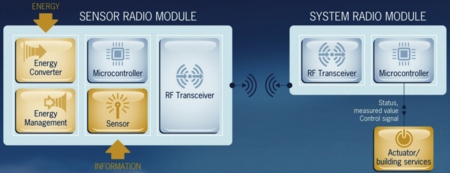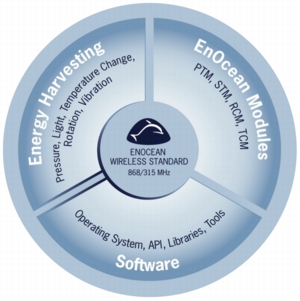EnOcean advances the technology of wireless sensors

Energy-harvesting wireless modules that can be used in building-management systems can receive, transmit and measure data only when required — and consequently consume very little energy. Armin Anders discusses the implications.
Energy-harvesting technology has made huge progress in recent years. There is now a diverse range of energy-saving electronic products on the market that draw energy from their surroundings. EnOcean, with its batteryless wireless modules, is a pacesetter in this development, showing the way to fully energy-autonomous applications.
The energy-harvesting interface of the STM 300 wireless module, for example, enables the connection of diverse energy converters. The module can be programmed so that measured values can be read out by means of the energy supplied by a tiny solar cell, for instance, and the result can trigger different activities. However, it is not only energy harvesting technology that positions such products under the ‘green’ banner. Even more energy is saved using unique wireless technology and the technique which turns modules off when they are not in use.
Responding fast and resting long
Self-powered wireless technology eliminates the need for replacing batteries and the time and resources this involves. Mechanical or thermo-electric converters and solar cells can act as a substitute for batteries if there is sufficient energy surplus to bridge periods when there is no energy to be harvested from the surroundings. The charge capacitor for this purpose stores energy for when there might not be enough light to operate an energy-harvesting module by a mini solar cell, for example. In complete darkness the stored energy will suffice for several days of regular operation. Different means of energy conversion and energy storage can be combined by applying a building block principle to match a range of different applications.
Used in building automation, energy-autonomous wireless systems must be able to work over distances of up to 30 m and through a number of walls. However, continuous operation of wireless transmitters or receivers would consume too much energy, and most of the sensor systems in a building process only relatively small amounts of data at intervals of several minutes. This is precisely what EnOcean technology makes use of. The modules save a large amount of energy by executing all operations of the sensors and actuators very rapidly, and consistently turning off modules when they are not needed. For this purpose the sensor modules incorporate special timers that require only about 20 nA (10-9 A) of current, fully cutting out all other components during the sleep phases and waking them again when they are required to operate.
Turning a sensor on and off quickly also saves energy. This approach is especially effective if the parameters to be measured change slowly, because very small action cycles can be achieved. When analysing processes that are highly dynamic as a function of time, however, such as vibration of machine parts, it is an advantage if the measured values are processed first. In a case like this no measured data is transmitted — only the status, decisions or warnings. The STM 110 sensor module, for instance, only sends measured values if there is a change from what it last sent — after all, it takes more energy to transmit than to measure.

Multiple wireless telegrams with minimal energy
Similar to the sensor functions, in wireless transmission the focus is also on saving — activate fast and turn off again. Data transmission in EnOcean wireless technology takes only 0.6 ms for a complete telegram. For extra data security, each telegram is repeated twice in the space of about 30 ms, with a randomly controlled delay between the three transmitted pulses. This high-speed and very short multiple transmission means that hundreds of transmitters can work in parallel in narrow confines on the same wireless frequency. Each EnOcean module comes with a unique 32-bit identification number to exclude any possibility of overlap with other wireless switches. The range is 300 m in the open and up to 30 m inside buildings. Although transmitted power is up to 10 mW, the wireless transmission technology used only has an energy requirement of 50 mWs for a single telegram. That is less than the energy used by a 60 W light bulb in a millisecond. Requiring so little energy, a sensor can be powered simply by operating a light switch.
Wireless solutions for bidirectional communication
With the introduction of the Dolphin platform, EnOcean now enables the creation of compact plug-and-play modules that are energy-autonomous and bidirectional. The major components of the bi-directional Dolphin system architecture are the wireless modules. At the core of these three modules is the Dolphin EO3000I, a compact application-specific integrated circuit (ASIC) that integrates both RF technology and flexibly programmed digital electronics on an extremely miniature scale. Only a few parts are needed to create a bidirectional wireless sensor — such as a crystal, an antenna and the power supply. With its energy-converter interface and complete RF transceiver, the ASIC enables extremely short, and thus energy-saving, data telegrams.
The range of Dolphin-supported solutions is already wide. Examples include self-powered applications in condition-monitoring and bi-directional gateways and repeaters with very low power consumption. OEM partners of EnOcean continue to work on products enabled by this energy-harvesting, bi-directional wireless technology. In the near future, entirely new, energy-saving application possibilities are expected in building automation and industry.
Armin Anders is VP for product marketing and co-founder of EnOcean GmbH








